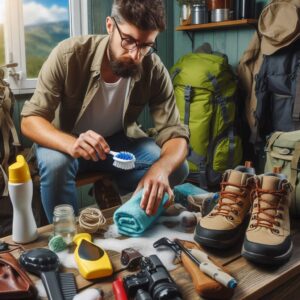 So, you’ve just spent a small fortune on some top-notch outdoor gear. Maybe you’re scaling Everest, camping in the wilderness, or simply trying to dodge your in-laws for a weekend. Either way, that gear of yours is like Batman’s Robin—always there to back you up, but only if you give it the TLC it deserves.
So, you’ve just spent a small fortune on some top-notch outdoor gear. Maybe you’re scaling Everest, camping in the wilderness, or simply trying to dodge your in-laws for a weekend. Either way, that gear of yours is like Batman’s Robin—always there to back you up, but only if you give it the TLC it deserves.
Now, picture this: You’re out in the middle of nowhere, feeling all rugged and adventurous. Suddenly, your tent zipper decides it’s had enough of life and quits on you during a downpour. Not fun, right? That’s why taking care of your equipment is crucial.
Think of your gear as an investment. Would you buy a Ferrari and then skip oil changes? I didn’t think so. The same logic applies here. Keep things clean and dry; store them properly; maybe even whisper sweet nothings to them at night (okay, maybe not that last one).
In short, treat your gear well and it’ll stick with you through thick and thin—like that one friend who always shows up with pizza when you’ve had a bad day. Neglect it, and you’ll be left high and dry—or worse yet, soaked—in the great outdoors.
Clean It Like Your Life Depends on It (Because It Might)
 Let’s get real here. Outdoor gear isn’t just expensive; it’s your lifeline out there in the wild. Imagine this: You’re halfway up a mountain, feeling like a rockstar, when you notice your harness is fraying because you never bothered to clean off the last three layers of mud. Not exactly inspiring confidence, right?
Let’s get real here. Outdoor gear isn’t just expensive; it’s your lifeline out there in the wild. Imagine this: You’re halfway up a mountain, feeling like a rockstar, when you notice your harness is fraying because you never bothered to clean off the last three layers of mud. Not exactly inspiring confidence, right?
First up, clothing. After a long trip, your clothes might smell like you’ve been rolling around in the wilderness—which, let’s be honest, you have.
The solution? Wash them according to the label instructions. And no, that doesn’t mean dumping everything in hot water and hoping for the best like some kind of laundry roulette. Technical fabrics need a little more love—think cold water and gentle detergents.
Now let’s talk footwear. You’d think your boots are indestructible because they cost as much as a small car payment, but surprise—they’re not! Mud, sweat, and random gunk can break down materials faster than you can say “I need new boots.”
Clean them off after every adventure and apply some leather conditioner or fabric protector based on what they’re made of. Also, never store them while they’re wet unless you’re really into that unique mildew aroma.
And sleeping bags—oh boy! It’s not just a blanket with a zipper, folks. Your sleeping bag is basically your bed in the wild. Turn it inside out, air it out regularly, and if it’s reached peak grossness levels, wash it in a front-loading machine with mild soap.
Do not—I repeat—do not tumble dry it on high heat unless you’re aiming to turn it into a toddler-sized sleeping bag.
Store It Like You Mean It
 Let’s be real for a second. You wouldn’t stuff your tuxedo in the back of your closet, right? (Or maybe you would, but let’s not dig into your fashion choices today.) Your outdoor gear deserves better than being crammed into a damp basement or left to marinate in the trunk of your car like last week’s leftovers.
Let’s be real for a second. You wouldn’t stuff your tuxedo in the back of your closet, right? (Or maybe you would, but let’s not dig into your fashion choices today.) Your outdoor gear deserves better than being crammed into a damp basement or left to marinate in the trunk of your car like last week’s leftovers.
So, how do we give our beloved gear the royal treatment it deserves? Buckle up; here comes the guide.
Tents: First off, before you even think about shoving that tent into its bag like it’s some kind of sad sausage, make sure it’s dry. And I mean *completely* dry. If there’s even a hint of moisture lurking around, congratulations! You’ve just created an all-inclusive mold spa retreat.
Once it’s bone-dry—like “I could use this as a sunbathing spot” dry—loose fold or roll it up and store it in a cool, dry place. Seriously, those extra ten minutes spent now will save you from playing “Guess That Smell” when you unpack next season.
Backpacks: Now onto backpacks. Before you toss that thing back on the shelf like it’s yesterday’s news, take a moment to empty out all those candy wrappers, crumpled maps from trips you never took, and random sticks that seemed cool at the time (we all have that one friend who collects sticks).
Wipe down the interior and exterior until it sparkles—or at least until it no longer resembles a small ecosystem—and then hang it up or store it flat.
Stuffing it into a corner is just asking for trouble; it’ll mess with the frame and padding faster than you can say “backpack ergonomics.”
Cooking Gear: And then there’s cooking gear. If you’re one of those adventurous souls who enjoys their coffee tasting like last night’s chili because cleaning is overrated—well, more power to you! But for the rest of us who prefer our meals without surprise flavors from past culinary experiments, scrub everything clean after each trip.
Make sure everything is dry before putting them away because nobody wants to open their cooking kit only to find what looks like a science experiment gone wrong waiting inside.
Store these items somewhere they won’t get banged up—because trust me, nothing ruins an outdoor meal faster than finding your frying pan dented like it’s been through a demolition derby.
Let’s Talk Repairs: Because Crying on Instagram Isn’t a Solution
 Alright, folks, let’s face it: stuff breaks. It’s like the universe has a vendetta against your outdoor gear. But before you toss that broken item into the abyss of “things I used to love” or pour your heart out in an Instagram story (complete with dramatic music), how about we take a different route?
Alright, folks, let’s face it: stuff breaks. It’s like the universe has a vendetta against your outdoor gear. But before you toss that broken item into the abyss of “things I used to love” or pour your heart out in an Instagram story (complete with dramatic music), how about we take a different route?
You don’t need to be some DIY sorcerer wielding a wand made of duct tape and hope to tackle basic repairs. Trust me; even I can manage it, and I once tried to fix my toaster by talking nicely to it.
Clothing: So, you’ve got a tear in your jacket. No biggie! Grab some fabric patches or channel your inner grandma with a needle and thread. Look, it doesn’t have to win any fashion awards—just needs to keep you warm and not look like something out of a horror movie.
And if you’re rocking one of those fancy waterproof jackets? A dab of seam sealer can work wonders. It’s like putting a Band-Aid on your jacket’s existential crisis.
Zippers: Now let’s talk zippers. If your tent zipper gets stuck, resist the urge to force it open like you’re trying to wrestle a jar of pickles at an awkward family barbecue.
Instead, grab some zipper lubricant (yes, that exists—no, it’s not just for secret agent gadgets) and gently coax it back and forth like you’re persuading an old friend to share their snacks. If that zipper is truly toast, don’t despair! A zipper repair kit could be your knight in shining armor—or at least in slightly tarnished metal.
Poles and Frames: Tent poles and backpack frames are tougher than they look but can still take quite the beating—like they just lost an arm wrestling match with gravity. Duct tape is basically the superhero of field repairs; slap some on there as a temporary fix while pretending you’re on an episode of “Survivor.”
But when you finally make it home and want something more permanent than “duct-tape chic,” check online for replacement parts. Many companies sell individual poles and frame components so you can swap out what’s broken instead of splurging on an entirely new setup.
Think of it as giving your gear a second chance at life rather than sending it off to the great gear graveyard in the sky.
So next time something goes kaput, remember: fixing things might just save you from emotional breakdowns over lost gear—and who knows? You might discover hidden talents along the way!
Plan Ahead to Prevent Disaster: Because “Wing It” is Not a Strategy
Let’s get real for a second. You wouldn’t wander into the wild without a map, right? Unless you enjoy the thrill of getting lost and having your life flash before your eyes as you contemplate whether that squirrel is actually plotting against you.
So why treat your gear like it’s just some random stuff lying around? A little prep work can save you from turning your outdoor adventure into an episode of “Survivor: Gear Edition.”
Check It Before You Wreck It: Seriously, take a moment to inspect your gear before you head out. Look for frayed straps, holes that seem to have appeared overnight (thanks, gremlins), or anything else that could go wrong faster than you can say “I should have checked this.” If something looks off, fix it now or risk kicking yourself later—like when you realize that the only thing holding up your tent is sheer willpower and maybe a prayer.
Weatherproofing: Let’s talk about weatherproofing because not all gear is created equal. Some items are tough enough to withstand Mother Nature’s tantrums; others are like that friend who always forgets their wallet on pizza night.
Your boots, jackets, and tents need an extra layer of protection—think of it as sunscreen for your gear. Spray on some water repellent in the comfort of your garage instead of trying to dry out soggy equipment at a rainy campsite while cursing the heavens and wondering why you didn’t listen to me.
Know When to Let Go: Now here comes the hard truth: sometimes, despite all our best efforts, our gear reaches its expiration date. That sleeping pad that deflates every night like it’s auditioning for a role in “The Great Balloon Escape”? Or how about that rain jacket which leaks worse than a sieve during monsoon season? It might be time to upgrade.
But hey, look on the bright side—new gear shopping is basically Christmas morning for outdoor enthusiasts! You get to unwrap shiny new toys while pretending you’re going on an epic quest rather than just looking for somewhere quiet to nap in nature.
So there you have it! With just a bit of planning and care, you’ll keep disaster at bay and maybe even enjoy some sweet adventures without any unexpected surprises—unless they involve squirrels; those guys are unpredictable no matter what!
Conclusion: Don’t Be That Guy (or Gal)
You know the one I’m talking about. The person whose gear looks like it just survived a zombie apocalypse—ripped tents, frayed straps, and maybe even a couple of mysterious stains that could tell stories if they weren’t too traumatized. They’re the ones who keep borrowing your stuff because they didn’t bother to check their own gear before heading out.
“Hey, can I borrow your sleeping bag? Mine’s more like a deflated balloon.” Don’t be that guy—or gal. Seriously, nobody wants to be known as the outdoor version of that friend who shows up to a potluck empty-handed.
Take care of your gear, and it’ll take care of you. Think about it: in the great outdoors, your equipment is the only thing standing between you and an uncomfortable night spent shivering under a tree while contemplating life choices. You want your tent to hold up against that unexpected downpour, not turn into an impromptu swimming pool.
So here’s the deal: treat your gear like a cherished friend. Clean it after every adventure like you’re trying to impress it for date night.
Store it properly—don’t just toss it in the corner with last year’s Christmas decorations and hope for the best. Repair what needs fixing instead of letting things fall apart like some tragic DIY project gone wrong.
And sure, I said “occasionally whisper sweet nothings” to your gear—but let’s keep that between us; we don’t need anyone thinking you’ve lost your mind out there! Just give it some love and attention, and trust me, when you’re out there facing nature’s fury, you’ll be glad you did.
After all, nothing ruins a camping trip faster than realizing you’re relying on something that should have been retired years ago! So go forth and embrace the great outdoors—just do it with well-maintained gear by your side!




